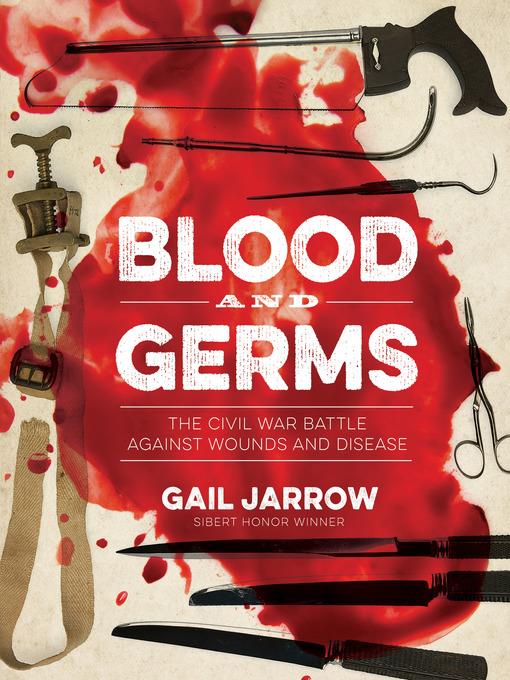
Blood and Germs
The Civil War Battle Against Wounds and Disease
فرمت کتاب
ebook
تاریخ انتشار
2020
Lexile Score
1030
Reading Level
6-8
ATOS
7.8
Interest Level
6-12(MG+)
نویسنده
Gail Jarrowشابک
9781635923346
کتاب های مرتبط
- اطلاعات
- نقد و بررسی
- دیدگاه کاربران
نقد و بررسی

August 1, 2020
For those interested in the history of medicine or fascinated by the Civil War, Jarrow's latest offering astutely combines both topics. The Civil War (1861-1865) was a bloodbath of epic size. Beyond the battlefield toll, boys who had never traveled far from home were gathered into huge armies and exposed to numerous diseases for which they had no immunity, leading to lethal epidemics and a huge further cost in young lives lost. Making outstanding use of period photographs, in-depth research, and firsthand accounts, this effort chronicles the inadequate, sometimes almost farcically deficient medical care delivered during the war. Highlighting primary topics in a series of brief chapters, it follows soldiers through the typical responses to being wounded (or falling ill), from frontline interventions through field hospitals, then, via torturous ambulance journeys, to immense pavilion hospitals that both Union and Confederate sides were forced to establish. Medical training, nursing care, the Union's Sanitary Commission, types of infections, prisoner-of-war mistreatment, and a discussion of medical advances that resulted from the war are also covered. The descriptions are sometimes graphic, connecting tragic statistics to individual soldiers. Sidebars neatly fit into the presentation, never interrupting the flow but enhancing the story with valuable additional information. Outstanding backmatter, more typical of what might be found in fine adult nonfiction, rounds out this stellar presentation. A fascinating example of excellence in juvenile nonfiction. (glossary, multiple source lists, detailed index) (Nonfiction. 10-15)
COPYRIGHT(2020) Kirkus Reviews, ALL RIGHTS RESERVED.

September 1, 2020
Grades 5-9 Although the concern with viruses is now ever-present, Jarrow shows in this well-documented informational book how germs and disease also shaped the Civil War. The Sibert Honor Book author opens with an overview of the Union and Confederate armies and initial perceptions of a short-lived conflict. It didn't take long, however, for the war to drag on and for epidemics to break out. In great and often gruesome detail, Jarrow describes how small pox, dysentery, gangrene, and other life-threatening diseases debilitated and even killed twice as many soldiers as bullets and artillery shells, as well as stomach-turning surgeries that often added to infection rates. Her emphasis throughout these chapters is on the lack of education concerning the spread of germs. Later chapters reveal how the war led to burgeoning innovations in modern medicine, from emergency triage to women's contributions in a new field of nursing. Archival photos on almost every page and sidebars about individual soldiers make the accounts personal and more harrowing. A time line and extensive online resources complete this masterful look at early medicine.(Reprinted with permission of Booklist, copyright 2020, American Library Association.)

September 28, 2020
Drawing from extensive archival sources, Jarrow (The Poison Eaters) debuts her Medical Fiascoes trilogy by skillfully narrating Civil War stories of soldiers who died not from bullets but from diseases such as typhus, typhoid, tuberculosis, gangrene, and malaria, and of the doctors and nurses who tried to save them. As Jarrow tells it, epidemics raged as fiercely as battles during the Civil War—thousands of soldiers died from measles and smallpox, which were so contagious that entire military regiments had to be disbanded and sent home. In the winter of 1862–63, one in six Confederate soldiers had pneumonia, but worst of all was chronic diarrhea, which “killed more Civil War soldiers than any other disease.” The book skillfully incorporates 19th-century newspaper typefaces and archival photographs, and employs eye-catching headings such as “Mercury and Maggots” and “Malignant Pus.” Jarrow also packs her pages with profiles of little-known heroes, such as Alexander Augusta, the first Black doctor to become a commissioned surgeon in the Union Army, and military doctor Mary Walker, the only woman to ever receive the Congressional Medal of Honor. The book’s timeline, glossary, and bibliography are also valuable resources. Ages 10–14.

November 1, 2020
Gr 7 Up-Jarrow (Fatal Fever: Tracking Down Typhoid Mary; The Poison Eaters: Fighting Danger and Fraud in Our Food and Drugs) provides another medical nonfiction work filled with viscerally repulsive images and facts. This book focuses on the death rates, diseases, and medical procedures of the American Civil War. One of the chapters, "Pus and Gangrene," sets the tone for the content. This is not a title for the sensitive stomach, as there are photos of amputated limbs, gangrenous sores, and corpses. However, readers who are drawn to the drama of sickness, death, and war will find this a fascinating overview. Broader statistics are supplemented by quotes from diaries and individual biographies of soldiers, doctors, and nurses. Historical photographs and news excerpts give this a narrative nonfiction feel. Shorter chapters with section headings make this a less daunting read. Some of the vocabulary and content lean towards technical. Younger readers might get overwhelmed or confused with some of the medical terms and quotes from historical sources. Older children will appreciate the compelling study of a time period where chopping off limbs and putting live maggots onto rotting flesh were regular medical practices. Jarrow also notes the contributions of women and people of color during an era that tends to focus on white men. VERDICT A good choice for middle and high school teachers or librarians who want to update their history section with a lively and attention-grabbing resource.-Sara Kundrik, Gilbert Paterson M.S., Alta.
Copyright 2020 School Library Journal, LLC Used with permission.

























دیدگاه کاربران